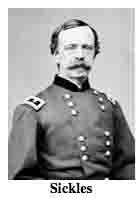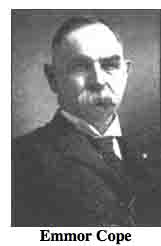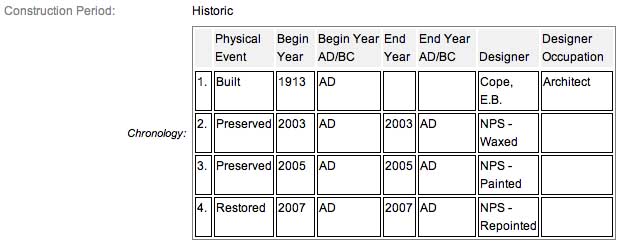
Daniel E. Sickles (October 20, 1819 – May 3, 1914) was a colorful and controversial American politician, Union general in the American Civil War, and diplomat. As an antebellum New York politician, Sickles was involved in a number of public scandals, most notably the killing of his wife's lover, Philip Barton Key II, son of Francis Scott Key. He was acquitted with the first use of temporary insanity as a legal defense in U.S. history. He became one of the most prominent political generals of the Civil War. At the Battle of Gettysburg, he insubordinately moved his III Corps to a position in which it was virtually destroyed, an action that continues to generate controversy; despite this, he would eventually be awarded the Medal of Honor in 1897. His combat career ended at Gettysburg when his leg was struck by cannon fire. After the war, Sickles commanded military districts during Reconstruction, served as U.S. Minister to Spain, and eventually returned to the U.S. Congress, where he made important legislative contributions to the preservation of the Gettysburg Battlefield. SOURCE
The Sickles' U.S. 3rd Corps Headquarters Marker is located across the road from the Trostle Barn at the Trostle farmstead. The monument is on the right or southwest side of the road if traveling southeast along the avenue. The monument and the Trostle Farm is south of Gettysburg on what is now United States Avenue. The farm and barn are on the left or northeast side of the road if traveling southwest along the Avenue. Owned by Peter Trostle, it was occupied at the time of the battle by his son Abraham, Abraham's wife Catherine, and their nine children. The 134 acre farm included a new frame house, brick barn, corn crib, wagon shed, springhouse, and a brick smokehouse. It is here where Sykes was wounded and lost his leg. Maj. Gen. Daniel E. Sickles, controversial commander of the Union Third Corps, established his headquarters beside the Trostle barn here. As Sickles' line began to collapse on the afternoon of July 2, a Confederate cannonball struck the general's right leg. A stretcher-bearer slowed the bleeding with a saddle-strap tourniquet. Army surgeons amputated the leg that night. Although many believe Sickles nearly lost Gettysburg for the Union, he helped to save it in 1895 by introducing legislation establishing Gettysburg National Military Park.  Parking is available in front of the barn and in front of the farm house. I visited the headquarters monument on Thursday, July 5, 2012 @ 4:44 PM, EDT & @ an altitude of 555 feet, ASL. I used a Canon PowerShot 14.1 Megapixel, SX210 IS digital camera for the photos.
Parking is available in front of the barn and in front of the farm house. I visited the headquarters monument on Thursday, July 5, 2012 @ 4:44 PM, EDT & @ an altitude of 555 feet, ASL. I used a Canon PowerShot 14.1 Megapixel, SX210 IS digital camera for the photos.
The monument was completed in June of 1913 according to the NPS/NRHP narrative and a few of my other sources. I know for sure the work was done under the direction of the Gettysburg National Park Commission (established by the United States Department of War), after they took over the administration of the park from the Gettysburg Battlefield Memorial Association (whose funds had expired) on March 3, 1893, and whose stewardship was then transferred to the National Park Service in 1933, (which entity still operates the park today). SOURCE
Description
Draw the Sword, with descriptive help from the NPS site (and me), offers the following description: Erected by the Gettysburg National Parks Commission and completed in June 1913; consists of steel cannon mounted on a granite base. Denotes the location of General Daniel E. Sickles, commander of the Third Corps. Rough-hewn, 3 course base, 3’2" sq. 2’7" high. Wrought iron, cannon tube mounted upright on base, w/ bronze lozenge (that's a diamond or rhombus) corps symbol attached. Overall height, 10’6? high. Bronze inscription tablet on North face.
This monument and the other nine for the Union were designed by designed by architect Colonel Emmor Bradley Cope (July 23, 1834 - May 28, 1927, working for the War Department).  I think there are only eight types of these rifles used of the ten that were made. He designed pretty much every tablet for both the Union & Rebel armies, each one distinct, w/ several different varieties as well as these headquarters markers. He was quite the engineer and one of the unsung heroes of the establishment of the Gettysburg Military Park. He is buried in Evergreen Cemetery
I think there are only eight types of these rifles used of the ten that were made. He designed pretty much every tablet for both the Union & Rebel armies, each one distinct, w/ several different varieties as well as these headquarters markers. He was quite the engineer and one of the unsung heroes of the establishment of the Gettysburg Military Park. He is buried in Evergreen Cemetery  in Gettysburg, as well he should be as this park and most of the things seen here today were designed by him and as such, are his legacy.
in Gettysburg, as well he should be as this park and most of the things seen here today were designed by him and as such, are his legacy.
The gun/cannon is a 4.5-inch iron Ordnance Rifles (also called a Siege Rifle), Model of 1861. My usual SITE for all things weaponry at Gettysburg usually has the registry information which can be found on the muzzle stamp. This thing is so high, I had no chance of reading it but this site has that information. The information in red is not part of the muzzle stamp but additional information cultivated by my source. That information reads as follows:
F.P.F. ......No. 80 ......1863 ......C.P.K. ......3577 ......FDY #1671 ......GRVS 9RH
Stamp Muzzle Explanation:
F.P.F represents Fort Pitt Foundry, Pittsburgh PA, the place where this cannon was manufactured. No. 80 Refers to the Army registration number, a way for the military to keep track of the guns when they take receipt of them from the various Union foundries. C.P.K. are the initials of Charles P. Kingsbury, the Union Ordnance Officer responsible for inspecting and accepting the final product to make sure it met all standards before the Army took receipt of the weapon. FDY #1671 refers to the foundry's internal control number of the cannon for their inventory purposes only. The Federal government required foundries to keep these numbers for quality control. 1863 refers to the production date, 1863. 3577 refers to the weight of the firing tube. Each gun is usually very unique and has its own weight which distinguishes it from every other gun, like a fingerprint. From my own experience after examining many of the cannons @ Gettysburg, this is the heaviest of the cannons I have found so far, more than 3 times as heavy as the common 12-pounder Napoleons found here. GRVS 9RH indicates this cannon was rifled or had grooves put into the bore. This refers to the number of rifling grooves, and if they were a right or left hand twist. Accordingly, this was 9 right hand twists. Rifling made the weapon much more accurate.
About the Foundry
The Fort Pitt Foundry was a nineteenth century iron foundry in Pittsburgh, Pennsylvania. It was originally established at Fifth Avenue and Smithfield Street in 1804 by Joseph McClurg, grandfather of Joseph W. McClurg. It was later moved to the area of Pittsburgh now known as the Strip District at 12th and Etna. It was an early producer of ordinance for the United States, and manufactured cannonballs for Commodore Oliver Hazard Perry's forces in the War of 1812. It was best known for the manufacture of large cannon. One of the largest was a 20 inch bore Rodman Gun, a large black powder, smoothbore, muzzle-loading coastal defense gun. The foundry was closed after the Civil War ended. It was eventually sold to a rival in 1878.
SOURCE
About the Gun (4.5-inch Siege Rifle)
The 4.5-inch siege rifle looks like a larger version of the 3-inch ordnance rifle and it is often called a 4.5-ordnance rifle. However, the 4.5-inch Siege rifle was of conventional cast iron construction and did not use the welded wrought iron construction of the 3-inch ordnance rifle. The 4.5-inch siege rifle fired shells weighing about 30 pounds (depending on the specific type of shell). It weighed 3,450 pounds and was 133 inches long. The gun’s only vice was that it suffered from excessive erosion of the vent caused by the hot gasses flowing through the vent when the gun was fired. The vent could be too large to fire the gun after 400 discharges. This problem could be remedied by insertion of a copper vent piece (bouche). In addition to its use as siege artillery, two batteries of 4.5- siege rifles (8 guns total) accompanied the Army of the Potomac as “heavy” field artillery between 1862 and 1864. The big guns were intended for long range firing against Confederate artillery. Although the guns showed very good mobility, they saw little action
SOURCE
About the Inspector
Charles P. Kingsbury (March 11, 1816 - December 25, 1879) was a graduate of the U. S. Military Academy at West Point, Class of 1840. He was a veteran of the Mexican War. He Served during the Rebellion of the Seceding States, 1861-66; as Superintendent of Harper’s Ferry Armory, Apr. 18-19, 1861, when destroyed to prevent its capture by a large threatening force of Rebels; in command of Kennebee Arsenal, Me., May 16 to Jun 1, 1861; as Chief of Ordnance of the Department of the Ohio, June 7, to Aug. 12, 1861, -- (Colonel, Staff – Additional Aide-de-Camp, Sep. 28, 1861) and of the Army of the Potomac, Aug. 12, 1861, to July 15, 1862, being engaged in the Virginia Peninsular Campaign of 1862, from the Siege of Yorktown through the “Seven Days’ Battles before Richmond,” till relieved, by reason of sickness, at Harrison’s Landing; on special duty for the War Department to the Governors of Iowa, Missouri, Illinois, Indiana, Ohio, Pennsylvania, Maryland, New Jersey, New York, Connecticut, Rhode Island, Massachusetts, and New Hampshire, Aug. 18 to Nov. 19, 1862; as Inspector of Heavy Ordnance at Pittsburg, Pa., Nov. 19, 1862, to Aug. 1, 1863; in selecting site for and building Rock (Major, Ordnance, Mar. 3, 1863). SOURCE Kingsbury died in Brooklyn, N.Y. at the age of 61 and is buried at Green-Wood Cemetery also in Brooklyn, NY. Kingsbury's obituary can be found HERE. (New York Times, Published: December 26, 1879)
There are two tablets, one on top of another. The inscriptions read:
 Army of the Potomac
Army of the Potomac
3d. Corps Headquarters
Major General
Daniel E. Sickles
July 1. 2. 1863
The Sickles' U.S. 3rd Corps Headquarters Marker is a contributing feature to the Gettysburg National Military Park Historic District which is nationally significant under NR Criteria A, B, C & D. Areas of Significance: Military, Politics/Government, Landscape Architecture, Conservation, Archeology-Historic. Period of Significance: 1863-1938. The original National Register Nomination was approved by the Keeper March 19, 1975. An update to this nomination was approved by the Keeper on January 23, 2004. The monument is identified as structure number MN454.
From the Nomination Form:
1 of 10 Civil War US Headquarters Markers in Park of the War Dept. Era (1895-1927). Marks location of Major General Sickles' 3 Corps Headquarters during Battle of Gettysburg, July 1-3, 1863. Locate on S side of Unites States Avenue near Trostle House.
Short Physical Description:
Rough-hewn, 3-course base 3'2" sq., 2'7" high. Wrought iron cannon tube mounted upright on base w/ bronze lozenge corps symbol attached. Overall height, 10'6" high. Bronze inscription tablet on N face.
Long Physical Description:
N/A

My Sources
1.
NRHP Nomination Form
2.
Stone Sentinels
3.
Virtual Gettysburg
4.
Draw the Sword
5.
Historical Marker Database
6.
Wikipedia